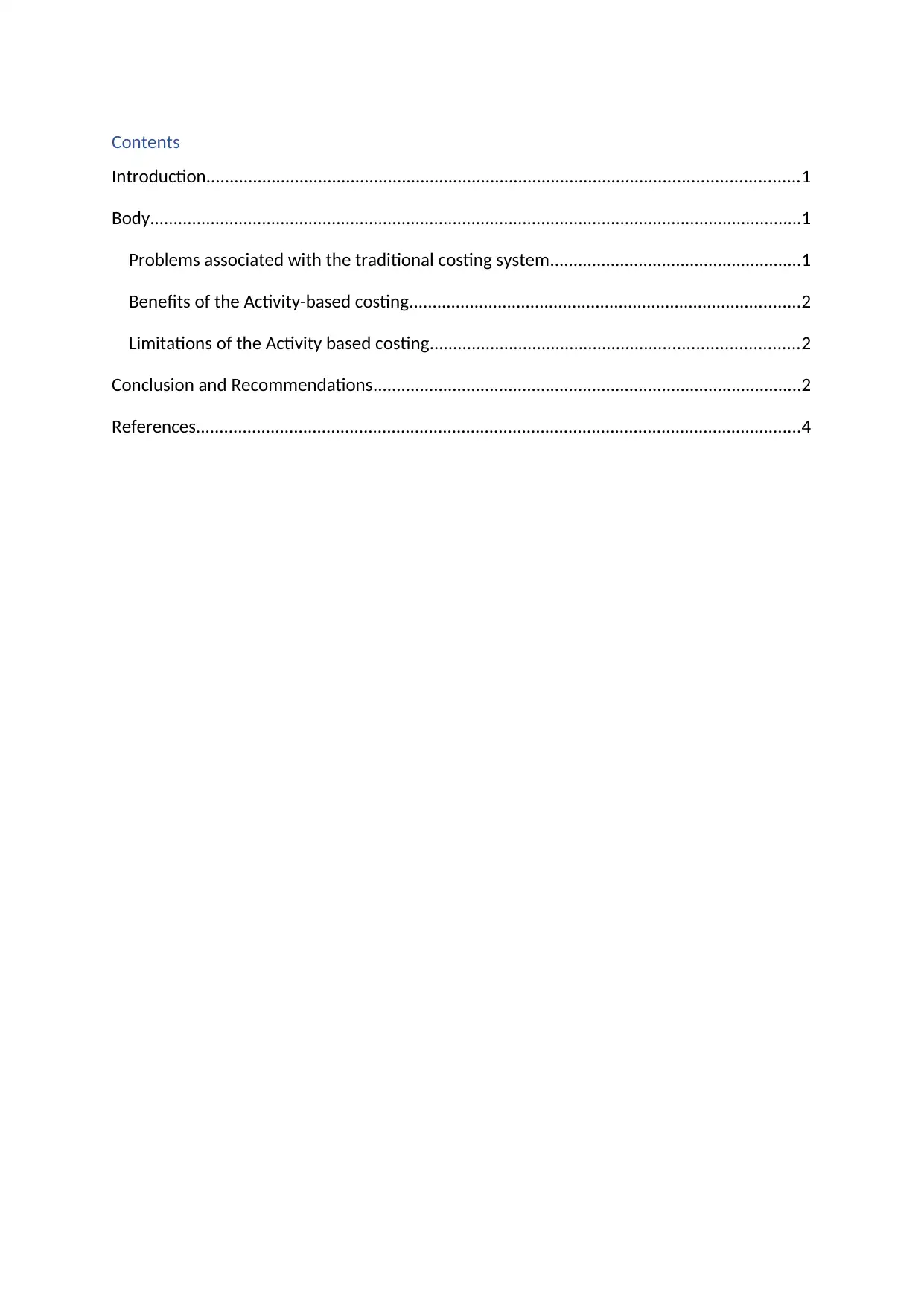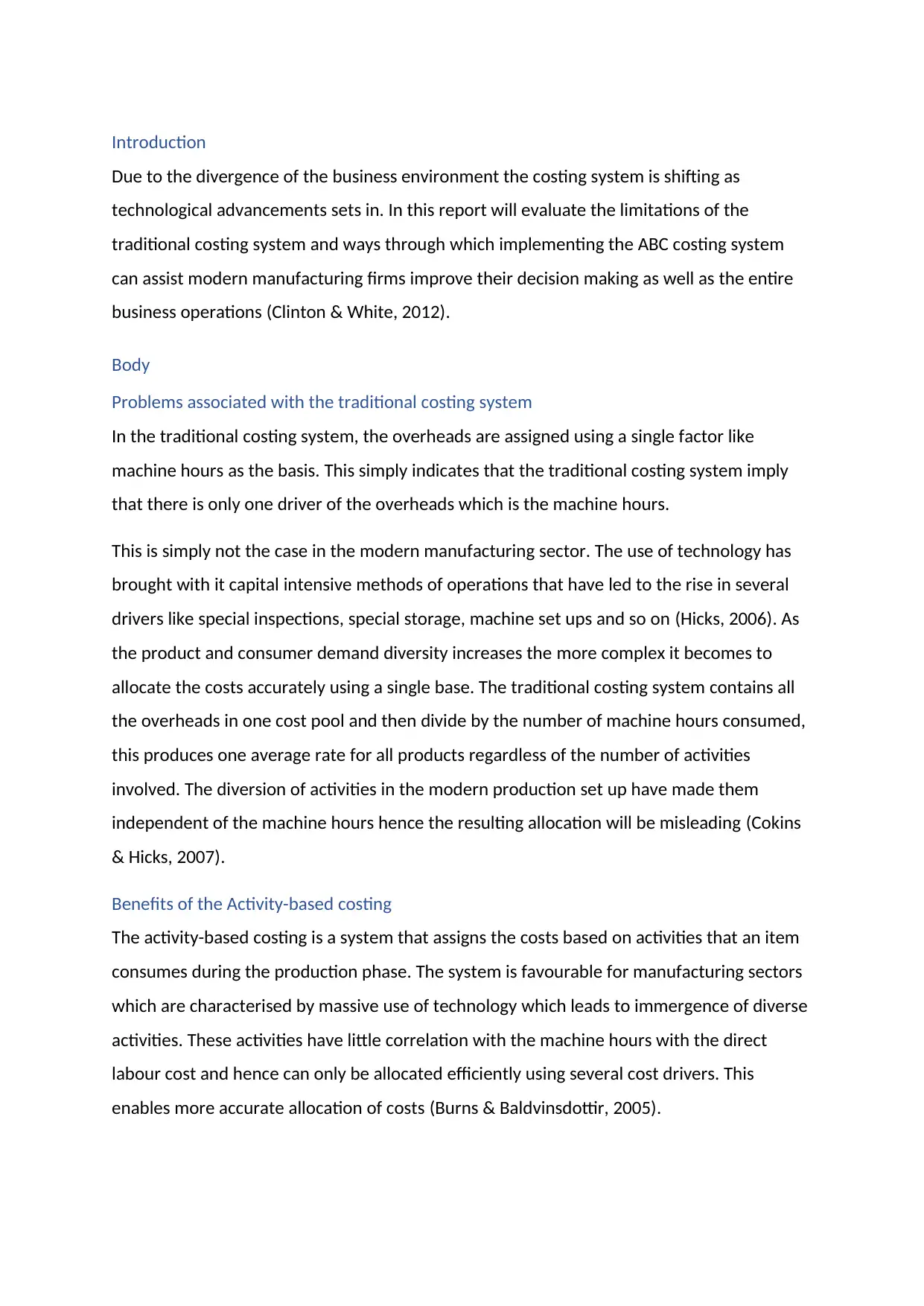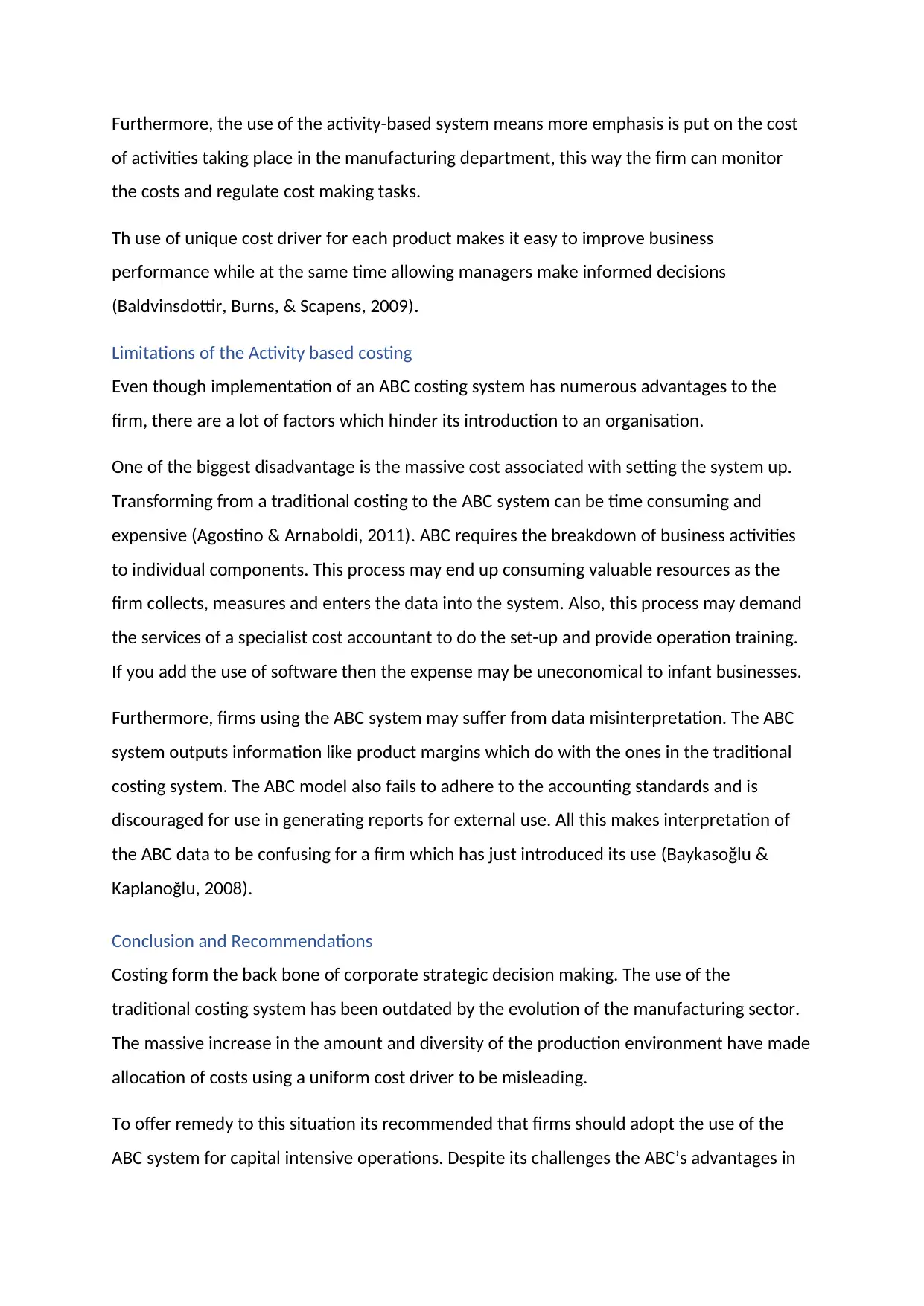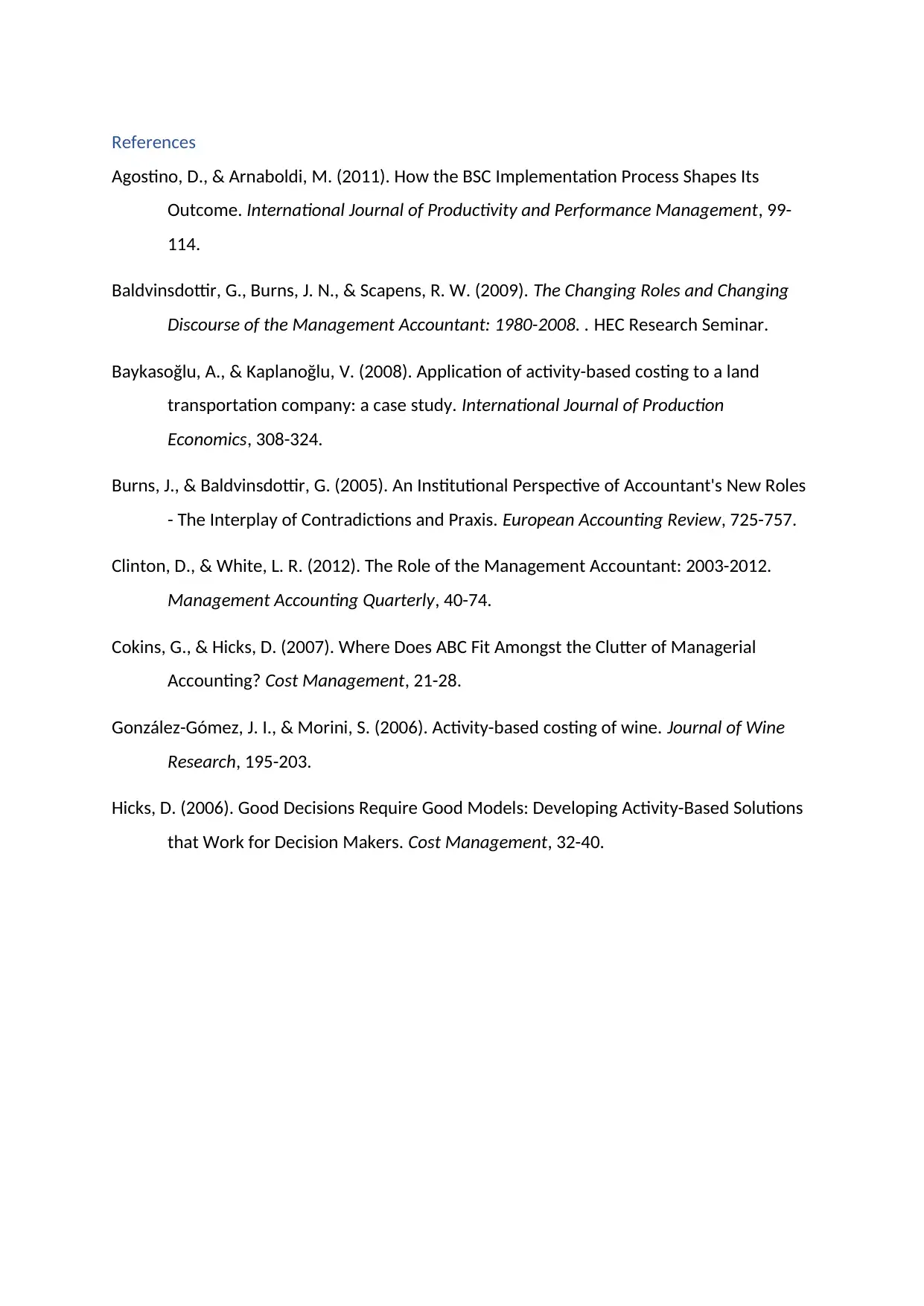BB210 Introductory Management Accounting: A Report on Costing Systems
VerifiedAdded on 2023/06/11
|6
|1118
|424
Report
AI Summary
This report investigates the traditional costing system and its limitations in modern firms, advocating for Activity-Based Costing (ABC) as a more accurate alternative. It details the problems associated with traditional costing, such as inaccurate overhead allocation due to reliance on single factors like machine hours, which fails to capture the complexity of modern manufacturing. The report then outlines the benefits of ABC, including its ability to assign costs based on activities, providing a more precise cost allocation and enabling better cost management. However, it also acknowledges the limitations of ABC, such as high implementation costs and potential data misinterpretation. The report concludes by recommending that firms adopt ABC for capital-intensive operations despite its challenges, emphasizing its advantages in controlling and providing accurate costs for improved decision-making. References are provided to support the analysis and recommendations.

Executive Summary
The report investigated the costing system. It began by highlighting the loopholes left by the
use traditional costing system to the modern firms. In this case inaccurate costing have been
highlighted as the major challenge. To solve this ABC costing have been recommended for
modern firms as it allocates costs based on activity hence allowing a more accurate estimate
of costs.
The report investigated the costing system. It began by highlighting the loopholes left by the
use traditional costing system to the modern firms. In this case inaccurate costing have been
highlighted as the major challenge. To solve this ABC costing have been recommended for
modern firms as it allocates costs based on activity hence allowing a more accurate estimate
of costs.
Paraphrase This Document
Need a fresh take? Get an instant paraphrase of this document with our AI Paraphraser

Contents
Introduction...............................................................................................................................1
Body............................................................................................................................................1
Problems associated with the traditional costing system......................................................1
Benefits of the Activity-based costing....................................................................................2
Limitations of the Activity based costing...............................................................................2
Conclusion and Recommendations............................................................................................2
References..................................................................................................................................4
Introduction...............................................................................................................................1
Body............................................................................................................................................1
Problems associated with the traditional costing system......................................................1
Benefits of the Activity-based costing....................................................................................2
Limitations of the Activity based costing...............................................................................2
Conclusion and Recommendations............................................................................................2
References..................................................................................................................................4

Introduction
Due to the divergence of the business environment the costing system is shifting as
technological advancements sets in. In this report will evaluate the limitations of the
traditional costing system and ways through which implementing the ABC costing system
can assist modern manufacturing firms improve their decision making as well as the entire
business operations (Clinton & White, 2012).
Body
Problems associated with the traditional costing system
In the traditional costing system, the overheads are assigned using a single factor like
machine hours as the basis. This simply indicates that the traditional costing system imply
that there is only one driver of the overheads which is the machine hours.
This is simply not the case in the modern manufacturing sector. The use of technology has
brought with it capital intensive methods of operations that have led to the rise in several
drivers like special inspections, special storage, machine set ups and so on (Hicks, 2006). As
the product and consumer demand diversity increases the more complex it becomes to
allocate the costs accurately using a single base. The traditional costing system contains all
the overheads in one cost pool and then divide by the number of machine hours consumed,
this produces one average rate for all products regardless of the number of activities
involved. The diversion of activities in the modern production set up have made them
independent of the machine hours hence the resulting allocation will be misleading (Cokins
& Hicks, 2007).
Benefits of the Activity-based costing
The activity-based costing is a system that assigns the costs based on activities that an item
consumes during the production phase. The system is favourable for manufacturing sectors
which are characterised by massive use of technology which leads to immergence of diverse
activities. These activities have little correlation with the machine hours with the direct
labour cost and hence can only be allocated efficiently using several cost drivers. This
enables more accurate allocation of costs (Burns & Baldvinsdottir, 2005).
Due to the divergence of the business environment the costing system is shifting as
technological advancements sets in. In this report will evaluate the limitations of the
traditional costing system and ways through which implementing the ABC costing system
can assist modern manufacturing firms improve their decision making as well as the entire
business operations (Clinton & White, 2012).
Body
Problems associated with the traditional costing system
In the traditional costing system, the overheads are assigned using a single factor like
machine hours as the basis. This simply indicates that the traditional costing system imply
that there is only one driver of the overheads which is the machine hours.
This is simply not the case in the modern manufacturing sector. The use of technology has
brought with it capital intensive methods of operations that have led to the rise in several
drivers like special inspections, special storage, machine set ups and so on (Hicks, 2006). As
the product and consumer demand diversity increases the more complex it becomes to
allocate the costs accurately using a single base. The traditional costing system contains all
the overheads in one cost pool and then divide by the number of machine hours consumed,
this produces one average rate for all products regardless of the number of activities
involved. The diversion of activities in the modern production set up have made them
independent of the machine hours hence the resulting allocation will be misleading (Cokins
& Hicks, 2007).
Benefits of the Activity-based costing
The activity-based costing is a system that assigns the costs based on activities that an item
consumes during the production phase. The system is favourable for manufacturing sectors
which are characterised by massive use of technology which leads to immergence of diverse
activities. These activities have little correlation with the machine hours with the direct
labour cost and hence can only be allocated efficiently using several cost drivers. This
enables more accurate allocation of costs (Burns & Baldvinsdottir, 2005).
⊘ This is a preview!⊘
Do you want full access?
Subscribe today to unlock all pages.

Trusted by 1+ million students worldwide

Furthermore, the use of the activity-based system means more emphasis is put on the cost
of activities taking place in the manufacturing department, this way the firm can monitor
the costs and regulate cost making tasks.
Th use of unique cost driver for each product makes it easy to improve business
performance while at the same time allowing managers make informed decisions
(Baldvinsdottir, Burns, & Scapens, 2009).
Limitations of the Activity based costing
Even though implementation of an ABC costing system has numerous advantages to the
firm, there are a lot of factors which hinder its introduction to an organisation.
One of the biggest disadvantage is the massive cost associated with setting the system up.
Transforming from a traditional costing to the ABC system can be time consuming and
expensive (Agostino & Arnaboldi, 2011). ABC requires the breakdown of business activities
to individual components. This process may end up consuming valuable resources as the
firm collects, measures and enters the data into the system. Also, this process may demand
the services of a specialist cost accountant to do the set-up and provide operation training.
If you add the use of software then the expense may be uneconomical to infant businesses.
Furthermore, firms using the ABC system may suffer from data misinterpretation. The ABC
system outputs information like product margins which do with the ones in the traditional
costing system. The ABC model also fails to adhere to the accounting standards and is
discouraged for use in generating reports for external use. All this makes interpretation of
the ABC data to be confusing for a firm which has just introduced its use (Baykasoğlu &
Kaplanoğlu, 2008).
Conclusion and Recommendations
Costing form the back bone of corporate strategic decision making. The use of the
traditional costing system has been outdated by the evolution of the manufacturing sector.
The massive increase in the amount and diversity of the production environment have made
allocation of costs using a uniform cost driver to be misleading.
To offer remedy to this situation its recommended that firms should adopt the use of the
ABC system for capital intensive operations. Despite its challenges the ABC’s advantages in
of activities taking place in the manufacturing department, this way the firm can monitor
the costs and regulate cost making tasks.
Th use of unique cost driver for each product makes it easy to improve business
performance while at the same time allowing managers make informed decisions
(Baldvinsdottir, Burns, & Scapens, 2009).
Limitations of the Activity based costing
Even though implementation of an ABC costing system has numerous advantages to the
firm, there are a lot of factors which hinder its introduction to an organisation.
One of the biggest disadvantage is the massive cost associated with setting the system up.
Transforming from a traditional costing to the ABC system can be time consuming and
expensive (Agostino & Arnaboldi, 2011). ABC requires the breakdown of business activities
to individual components. This process may end up consuming valuable resources as the
firm collects, measures and enters the data into the system. Also, this process may demand
the services of a specialist cost accountant to do the set-up and provide operation training.
If you add the use of software then the expense may be uneconomical to infant businesses.
Furthermore, firms using the ABC system may suffer from data misinterpretation. The ABC
system outputs information like product margins which do with the ones in the traditional
costing system. The ABC model also fails to adhere to the accounting standards and is
discouraged for use in generating reports for external use. All this makes interpretation of
the ABC data to be confusing for a firm which has just introduced its use (Baykasoğlu &
Kaplanoğlu, 2008).
Conclusion and Recommendations
Costing form the back bone of corporate strategic decision making. The use of the
traditional costing system has been outdated by the evolution of the manufacturing sector.
The massive increase in the amount and diversity of the production environment have made
allocation of costs using a uniform cost driver to be misleading.
To offer remedy to this situation its recommended that firms should adopt the use of the
ABC system for capital intensive operations. Despite its challenges the ABC’s advantages in
Paraphrase This Document
Need a fresh take? Get an instant paraphrase of this document with our AI Paraphraser

controlling and availing accurate costs is worth investing in (González-Gómez & Morini,
2006).
2006).

References
Agostino, D., & Arnaboldi, M. (2011). How the BSC Implementation Process Shapes Its
Outcome. International Journal of Productivity and Performance Management, 99-
114.
Baldvinsdottir, G., Burns, J. N., & Scapens, R. W. (2009). The Changing Roles and Changing
Discourse of the Management Accountant: 1980-2008. . HEC Research Seminar.
Baykasoğlu, A., & Kaplanoğlu, V. (2008). Application of activity-based costing to a land
transportation company: a case study. International Journal of Production
Economics, 308-324.
Burns, J., & Baldvinsdottir, G. (2005). An Institutional Perspective of Accountant's New Roles
- The Interplay of Contradictions and Praxis. European Accounting Review, 725-757.
Clinton, D., & White, L. R. (2012). The Role of the Management Accountant: 2003-2012.
Management Accounting Quarterly, 40-74.
Cokins, G., & Hicks, D. (2007). Where Does ABC Fit Amongst the Clutter of Managerial
Accounting? Cost Management, 21-28.
González-Gómez, J. I., & Morini, S. (2006). Activity-based costing of wine. Journal of Wine
Research, 195-203.
Hicks, D. (2006). Good Decisions Require Good Models: Developing Activity-Based Solutions
that Work for Decision Makers. Cost Management, 32-40.
Agostino, D., & Arnaboldi, M. (2011). How the BSC Implementation Process Shapes Its
Outcome. International Journal of Productivity and Performance Management, 99-
114.
Baldvinsdottir, G., Burns, J. N., & Scapens, R. W. (2009). The Changing Roles and Changing
Discourse of the Management Accountant: 1980-2008. . HEC Research Seminar.
Baykasoğlu, A., & Kaplanoğlu, V. (2008). Application of activity-based costing to a land
transportation company: a case study. International Journal of Production
Economics, 308-324.
Burns, J., & Baldvinsdottir, G. (2005). An Institutional Perspective of Accountant's New Roles
- The Interplay of Contradictions and Praxis. European Accounting Review, 725-757.
Clinton, D., & White, L. R. (2012). The Role of the Management Accountant: 2003-2012.
Management Accounting Quarterly, 40-74.
Cokins, G., & Hicks, D. (2007). Where Does ABC Fit Amongst the Clutter of Managerial
Accounting? Cost Management, 21-28.
González-Gómez, J. I., & Morini, S. (2006). Activity-based costing of wine. Journal of Wine
Research, 195-203.
Hicks, D. (2006). Good Decisions Require Good Models: Developing Activity-Based Solutions
that Work for Decision Makers. Cost Management, 32-40.
⊘ This is a preview!⊘
Do you want full access?
Subscribe today to unlock all pages.

Trusted by 1+ million students worldwide
1 out of 6
Related Documents
Your All-in-One AI-Powered Toolkit for Academic Success.
+13062052269
info@desklib.com
Available 24*7 on WhatsApp / Email
![[object Object]](/_next/static/media/star-bottom.7253800d.svg)
Unlock your academic potential
Copyright © 2020–2025 A2Z Services. All Rights Reserved. Developed and managed by ZUCOL.




